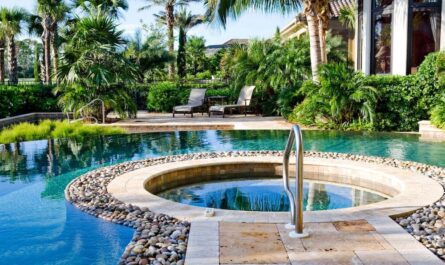
Key Takeaways:
- Learn the key elements of modern kitchen design that blend functionality with aesthetics.
- Gain insights on selecting materials and color schemes for a cohesive look.
- Discover how to integrate technology and sustainable practices into your kitchen.
Kitchens have long transformed from mere cooking zones to the epicenter of domestic life, serving as a backdrop for family gatherings, entertaining guests, and even working from home. As such, designing a kitchen that marries functionality with aesthetic appeal has become paramount. When you embark on this journey, creating a space that meets practical needs, exudes beauty, and reflects personal style is vital. Experts like those at Striking Remodels excel at blending these elements into stunning kitchen designs. This guide aims to unpack the integral components that make today’s kitchens timeless, ensuring they remain vibrant and functional for years.
From choosing high-quality materials to incorporating cutting-edge technology, the elements defining modern kitchens converge to create not just a cooking space but a welcoming oasis within your home. As we delve into the essentials, consider how each aspect can be tailored to mirror your lifestyle and cater to your tastes while enhancing the resale value of your home. Let’s explore the key elements crucial to a successful kitchen design that doesn’t just follow trends but establishes them.
Introduction to Modern Kitchen Design
Today’s kitchens have evolved far beyond their traditional roles as mere utilitarian spaces. They have become multifunctional hubs where culinary art meets social interactions. The kitchen has to be a well-designed space that effectively combines practicality with an aesthetic that resonates with its users. It’s not just about having a place to cook; it’s about creating an environment where memories are made and shared. A well-crafted kitchen combines design, technology, and sustainability elements, creating a space that enhances the home’s value and appeal.
The Core Elements of Modern Kitchen Design
Prioritize Functionality
Functionality should be at the forefront of any kitchen design, dictating the flow and usability of the space. Modern designs often emphasize open-plan layouts, which support a seamless transition between prep areas, cooking zones, and dining spaces. Efficient storage solutions, like walk-in pantries, pull-out drawers, and custom shelving, minimize clutter and maximize usability. Ergonomics are crucial here, offering easy access and comfort in a high-use environment. Consider how elements like kitchen islands and premium countertops can serve dual purposes, enhancing both workspace and style.
Aesthetic Appeal
While functionality is vital, aesthetic appeal gives a kitchen charm and character. Today’s kitchens favor clean lines and minimalistic, chic, inviting designs. Fusing classic elements, such as vintage hardware, with sleek modern finishes like glossy cabinetry and state-of-the-art appliances creates a dynamic and timeless aesthetic. This blend of traditional and contemporary elements forms a visually harmonized space that remains attractive and in style regardless of passing trends.
Material Selection for a Modern Aesthetic
The selection of materials in a kitchen significantly influences its overall look and sustainability. Optical elements such as countertops, flooring, and cabinetry are not just for visual appeal but contribute to the kitchen’s longevity and environmental impact. Opting for materials like quartz for countertops, which are known for their durability and resistance to wear, along with recycled materials for cabinetry, contributes to a greener footprint. Hardwood floors or large-format tiles can withstand heavy foot traffic while maintaining an elegant look. For deeper insights and inspiration, consider exploring sustainable kitchen design practices focusing on eco-friendly living.
Choosing the Right Color Palette
Color selection is a pivotal part of kitchen design, creating a mood that resonates throughout the space. Modern kitchens frequently embrace neutral tones like whites, grays, and beiges, which offer a timeless base from which to work. Meanwhile, integrating deep blues, vibrant reds, or even bold blacks as accent hues can add depth and personality to the space. Whether you’re adding color through statement backsplashes or more subtle means like decor and accessories, ensure that the color scheme ties the elements of your kitchen together for an inviting and coherent look.
Integration of Smart Technology
The role of technology in the kitchen has been rapidly evolving, transforming how we interact with this essential space. Bright kitchens now host an array of advanced appliances and devices, such as ovens you can preheat from your smartphone, refrigerators that keep track of your groceries, and faucets that dispense specific volume or temperature of water via voice command. These innovations boost convenience and often contribute to energy efficiency, aligning with broader environmental goals. To stay ahead in integrating technology, explore the latest innovative kitchen technology trends that fit seamlessly into modern living.
Lighting: The Unsung Hero of Kitchen Design
Lighting in a kitchen goes beyond functionality; it sets the tone and enhances the aesthetics. Implementing a layered lighting approach that includes direct task lighting above countertops and cooking areas, ambient lighting for overall illumination, and accent lighting to highlight specific design elements such as artwork or architectural features is essential. This approach ensures a well-lit space that is both practical and soothing, transforming the kitchen into a warm and welcoming environment.
Sustainability in Kitchen Design
As sustainability increasingly guides consumer choices, its role in kitchen design is more critical than ever. Selecting energy-efficient appliances, installing water-saving fixtures, and using materials that reduce environmental impact is critical to ensure eco-friendly kitchen spaces. Implementing waste reduction systems and considering renewable energy contributes significantly to a sustainable lifestyle. Homeowners can create beautiful, functional kitchens by focusing on these elements and proactively reduce their environmental footprint.
Bringing It All Together: Creating a Personal Haven
Ultimately, a kitchen should be a personal haven that reflects the occupants’ style and comfort. Personal touches through art, unique hardware, or custom-crafted furniture can add warmth to the design. When blending modern trends with timeless elements, the key is to focus on what resonates with your taste while ensuring practicality and appeal. This approach guarantees that the kitchen remains a beloved space in your home, catering to current and future needs.
